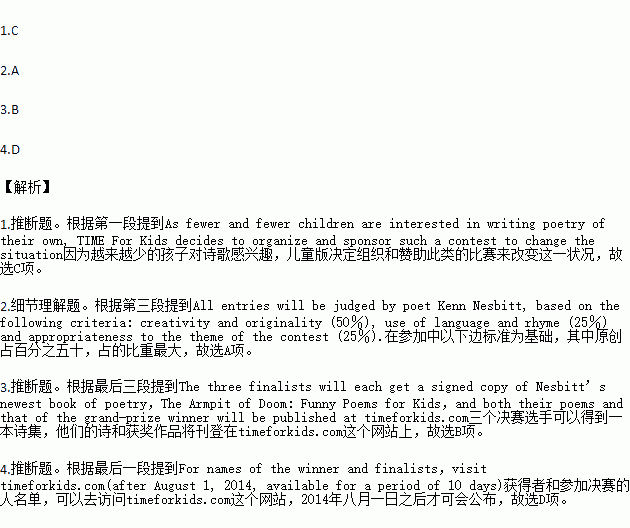题目内容
B
2014 TFK Poetry Contest
Calling all poets! TIME For Kids has a challenge for you:Write a funny, rhyming poem. It must be an original poem that does not copy another poet’s work. Enter it in the TIME For Kids Poetry Contest. As fewer and fewer children are interested in writing poetry of their own, TIME For Kids decides to organize and sponsor such a contest to change the situation.
Contest Rules
1. How to enter: This contest begins 12:01 am on March 6, 2014 and ends 11:59 pm on July 24, 2014. To enter, mail the following information to 1271 Avenue of the Americas, 32nd Floor, New York, New York 10020: (a) an original and previously unpublished poem that is humorous and has a rhyme scheme(韵律); (b) Entrant’s first name only and a parent’s mail address. Limit one entry per person. By entering, Entrant promises that the entry (1) is original, (2) has not been published in any medium and (3) has not won an award.
2. Judging: All entries will be judged by poet Kenn Nesbitt, based on the following criteria: creativity and originality (50%), use of language and rhyme (25%) and appropriateness to the theme of the contest (25%). The length of the entry will not be taken into consideration.
3. Prizes: Our judge will select four semifinalists(半决赛选手)from which one grand-prize winner and three finalists will be chosen. The one grand-prize winner will receive an online class visit from Children’s Poet Kenn Nesbitt and a signed copy of his newest book of poetry, The Armpit of Doom:Funny Poems for Kids, approximately value: $275. The three finalists will each get a signed copy of Nesbitt’s newest book of poetry,The Armpit of Doom: Funny Poems for Kids,and both their poems and that of the grand-prize winner will be published at timeforkids.com.
4. Eligibility(参赛资格):Open to legal citizens of the 50 United States and the District of Columbia who are primary school students and are 8 to 13 years old at time of entry.
5. Winner’s list:For names of the winner and finalists,visit timeforkids.com(after August 1, 2014, available for a period of 10 days).
1.The purpose of the contest is to__________.
A. encourage children to learn from other poets
B. help children realize the dream of poetry writing
C. encourage children’s interest in poetry writing
D. encourage children to read more original poems
2.Which of the following characteristics of a poem is valued most in judging?
A. Being creative and original.
B. Using a proper number of words.
C. Using proper language and rhyme.
D. Being appropriate to the contest theme.
3.What can be known about the finalists of the contest?
A. They will get a great deal of money.
B. Their poems can be read at timeforkids.com.
C. They will receive an online class visit from Nesbitt.
D. Their poems will appear in Nesbitt’s newest book of poetry.
4.According to the contest rules,____________.
A. poems can be sent to the organizers by e-mail
B. all children have the right to take part in the contest
C. the number of poems to enter the contest is not limited
D. the result of the contest will be unknown before August, 2014

